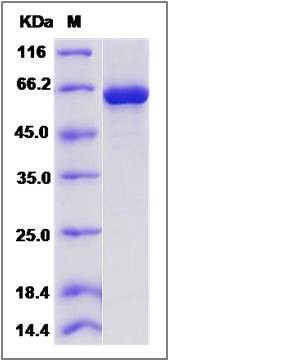Human EphA2 Protein (aa 585-976, His & GST Tag)
ARCC2,CTPA,CTPP1,CTRCT6,ECK
- 100ug (NPP3829) Please inquiry
| Catalog Number | P13926-H20B1 |
|---|---|
| Organism Species | Human |
| Host | Baculovirus-Insect Cells |
| Synonyms | ARCC2,CTPA,CTPP1,CTRCT6,ECK |
| Molecular Weight | The recombinant human EPHA2 /GST chimera consists of 629 amino acids and has a calculated molecular mass of 72.1 kDa. The recombinant protein migrates as an approximately 62 kDa band in SDS-PAGE under reducing conditions. |
| predicted N | Met |
| SDS-PAGE |  |
| Purity | > 95 % as determined by SDS-PAGE |
| Protein Construction | A DNA sequence encoding the human EPHA2 (P29317) (Leu585-Ile976) was fused with the N-terminal polyhistidine-tagged GST tag at the N-terminus. |
| Bio-activity | The specific activity was determined to be 50 nmol/min/mg using Poly(Glu:Tyr) 4:1 as substrate. |
| Research Area | Cancer |Signal transduction |Akt Pathway |Receptor Tyrosine Kinases (RTKs) in the Akt Pathway |
| Formulation | Supplied as sterile 20mM Tris, 500mM NaCl, 3mM DTT, pH 8.5, 10% gly 1. Normally 5 % - 8 % trehalose, mannitol and 0.01% Tween80 are added as protectants before lyophilization. Specific concentrations are included in the hardcopy of COA. |
| Background | Eph receptor A2 (Ephrin type-A receptor 2 or EphA2) is a member of the ephrin receptor subfamily of the protein-tyrosine kinase family. The Eph receptors' corresponding family of ligands are the ephrins anchored to cell surfaces. The ephrins and Eph receptors are implicated as positional labels that may guide the development of neural topographic maps. They have also been found implicated in embryonic patterning, neuronal targeting, vascular development and adult neovascularization. The large family of ligands and receptors may make a major contribution to the accurate spatial patterning of connections and cell position in the nervous system. Furthermore, elevated expression of Eph receptors and ephrin ligands is associated with tumors and associated tumor vasculature, suggesting the Eph receptors and ephrin ligands also play critical roles in tumor angiogenesis and tumor growth. Unlike most Eph kinases, which are primarily expressed during development, EphA2 is primarily found in adult human epithelial cells. The cellular functions of EphA2 may be regulating cell growth, survival, migration, and angiogenesis.Unlike other receptor tyrosine kinases, ligand binding is not necessary for EphA2. Rather, the ligand appears to regulate EphA2 subcellular localization and its interactions with downstream adapter and signaling proteins. Eph receptor A2(EphA2) has been demonstrated to critically regulate tumor cell growth, migration and invasiveness. Eph receptor A2(EphA2) is frequently overexpressed and functionally altered in aggressive tumor cells, and that these changes promote metastatic character. |
| Reference |
